Bok Choy Kimchi is a delightful simple side dish that not only adds a burst of taste to your meals but also offers a healthy dose of probiotics for your gut and immune system.
Bok choy, also known as pak choi or Chinese cabbage, originates from China. It has a long history of cultivation and consumption in Chinese cuisine, dating back over 1,500 years. Bok choy is one of the many leafy greens and vegetables that have been an integral part of Chinese culinary traditions for centuries.
Over time, bok choy’s popularity spread to other Asian countries, where it became a staple in Korean cuisine and Japanese cuisine.
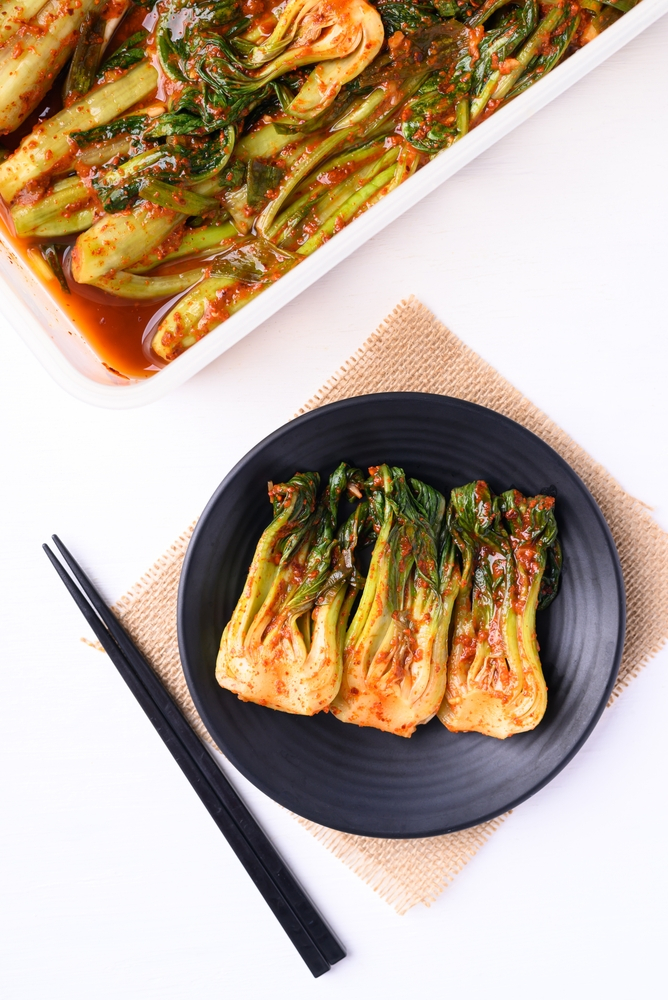
WHAT IS BOK CHOY?
Bok choy, also spelled as “pak choi” or “pac choi,” is a type of leafy green vegetable that is commonly used in Asian cuisine, particularly in Chinese and Korean dishes.
It belongs to the cabbage family (Brassicaceae) and is sometimes referred to as Chinese cabbage. Bok choy has a mild, slightly peppery flavor and a crisp texture, making it a versatile ingredient in a variety of dishes.
There are two main varieties of bok choy:
- Baby Bok Choy: This smaller variety is the most common and widely available. Baby bok choy has tender, pale green stems and dark green leaves. It is often used in stir-fries, soups, and salads.
- Shanghai Bok Choy: Shanghai bok choy, also known as “Shanghai pak choi” or “Shanghai bok choi,” is larger and has thicker stems compared to baby bok choy. It is commonly used in braised dishes and soups.
Bok choy is a nutritious vegetable and is an excellent source of vitamins, particularly vitamin C and vitamin K. It’s also rich in dietary fiber, which is beneficial for digestion. Additionally, bok choy contains various minerals and antioxidants.
When cooking with bok choy, you can use both the stems and the leaves. The stems are crisp and slightly sweet when cooked, while the leaves cook down to a tender texture.
Bok choy can be prepared in a variety of ways, including stir-frying, steaming, sautéing, and even in salads. It is a versatile ingredient that adds a fresh and slightly earthy flavor to dishes.
WHICH BOK CHOY TO USE
The choice between using baby bok choy or Shanghai bok choy depends on your personal preference and the specific dish you’re preparing. Here’s a guideline to help you decide which one to use:
- Baby Bok Choy:
- Tender and Delicate: Baby bok choy has tender, delicate stems and leaves. It’s less fibrous and cooks quickly, making it a good choice for dishes where you want a mild, fresh, and slightly crisp texture.
- Stir-Fries: Baby bok choy is commonly used in stir-fries, as it wilts quickly and absorbs flavors well. It’s great in stir-fry dishes with other vegetables, protein (like tofu, chicken, or shrimp), and various sauces.
- Shanghai Bok Choy (Shanghai Pak Choi):
- Robust and Thick: Shanghai bok choy has thicker stems and larger leaves compared to baby bok choy. It has a slightly stronger flavor and holds up better to longer cooking times.
- Braising and Soups: Shanghai bok choy is often used in braised dishes and soups because its thicker stems can withstand longer cooking without becoming overly soft. It adds a heartier texture to these dishes.
If you’re looking for a milder, delicate texture, and you plan to cook your bok choy quickly, baby bok choy is a good choice.
On the other hand, if you want a heartier texture and a slightly stronger flavor, or if you’re preparing a dish with longer cooking times, Shanghai bok choy may be the better option.
For this recipe we will be using baby bok choy.
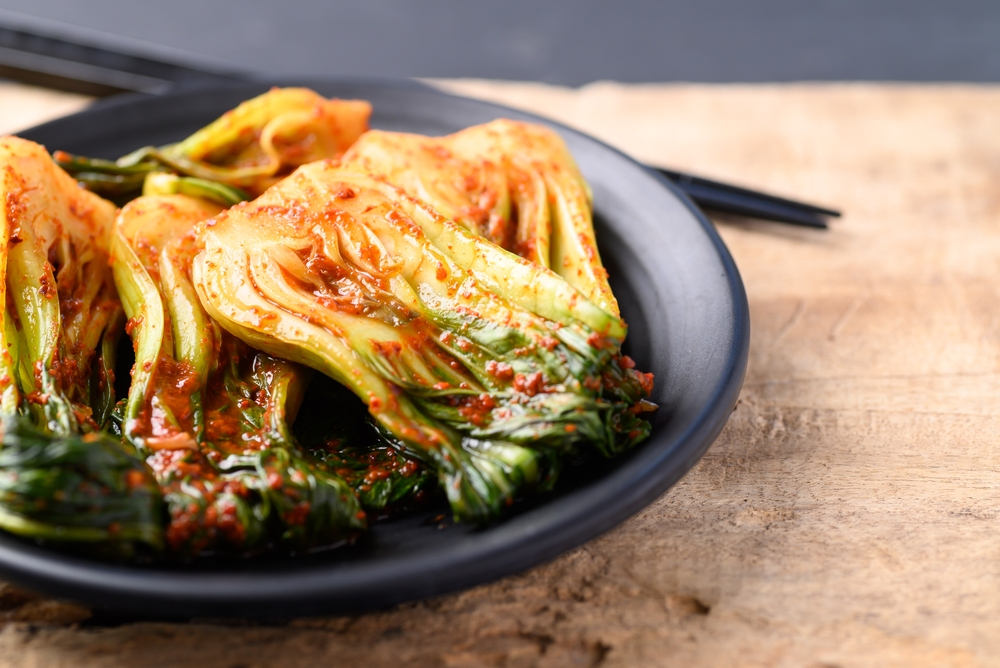
Quick Bok Choy Kimchi recipe
Ingredients:
- 4-6 baby bok choy heads
- 1 tablespoon kosher salt
- 2 cloves garlic, minced
- 1 teaspoon ginger, grated
- 1-2 teaspoons gochugaru (Korean red pepper flakes) or chili flakes (adjust to your spice preference)
- 1 teaspoon sugar
- 1 tablespoon soy sauce
- 1 tablespoon rice wine vinegar
- 1 teaspoon sesame oil
- 2 green onions, chopped
- 1 tablespoon toasted sesame seeds (optional, for garnish)
Instructions:
- Prepare the baby bok choy:
- Wash the baby bok choy thoroughly and cut them in half lengthwise.
- Salt the baby bok choy:
- In a very large bowl, dissolve the salt in about 2 cups of spring water.
- Submerge the bok choy halves in the saltwater, making sure they are completely covered.
- Allow the bok choy to soak in the salt water for about 20-30 minutes. This will help to draw out excess moisture.
- Rinse and drain:
- After soaking, rinse the bok choy under cold running water to remove excess salt.
- Drain them well and gently squeeze out any excess water. You want them to be slightly wilted but not soggy.
- Prepare the seasoning paste:
- In a small bowl, mix together the minced garlic, grated ginger, gochugaru (or chili flakes), sugar, soy sauce, rice vinegar, and sesame oil. Adjust the spice level and sweetness to your preference.
- Combine everything:
- Place the drained baby bok choy in a large mixing bowl.
- Add the green onions and the prepared seasoning paste to the bowl.
- Mix thoroughly:
- Using your hands or tongs, gently toss everything together, ensuring that the bok choy is well coated with the seasoning paste.
- Serve:
- Transfer the baby bok choy kimchi to a serving dish, and sprinkle with toasted sesame seeds if desired.
- Enjoy:
- You can enjoy your baby bok choy kimchi immediately, or you can let it sit at room temperature for 30 minutes to allow the flavors to meld a bit.
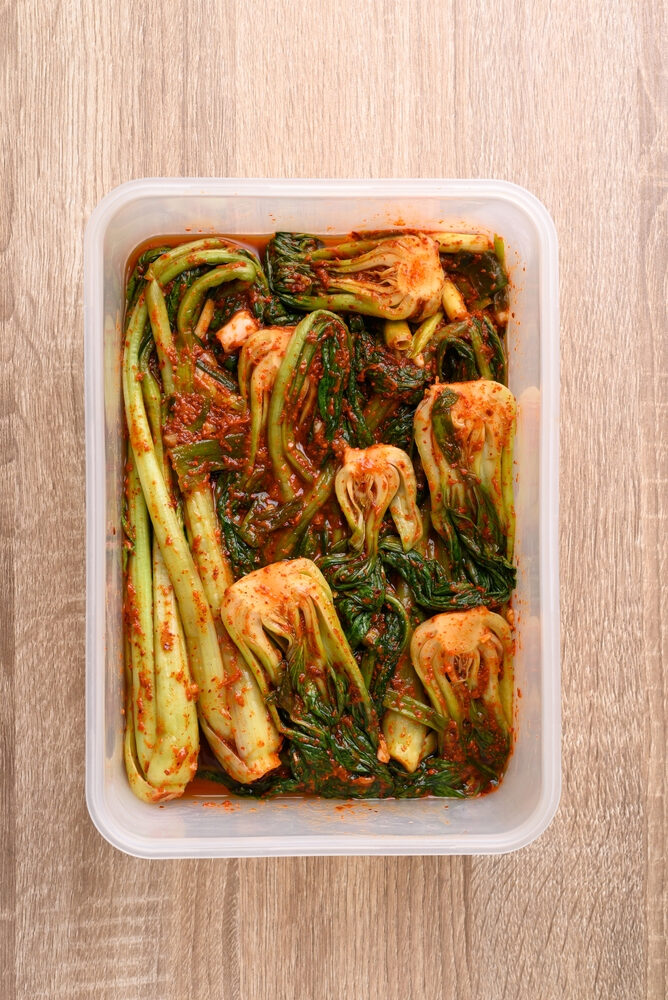
Remember that the fermentation process can vary depending on factors like room temperature and personal preference. The longer it ferments, the more tangy and flavorful it will become.
What To Eat with Bok Choy Kimchi
- Rice Dishes:
- Serve bok choy kimchi as a side dish with steamed white or brown rice. The combination of the slightly spicy, tangy kimchi and plain rice is a classic and satisfying pairing.
- Noodles:
- Add bok choy kimchi to your favorite noodle dishes, such as ramen, stir-fried noodles, or cold noodle salads. It can provide an extra layer of flavor and crunch.
- Bibimbap:
- Create a delicious bibimbap bowl with cooked rice, sautéed vegetables, a fried egg, and a generous spoonful of bok choy kimchi. Mix it all together with some gochujang (Korean red pepper paste) for a flavorful meal.
- Tofu or Meat Dishes:
- Use bok choy kimchi as a side dish for grilled tofu, chicken, beef, or pork. The kimchi’s spiciness and acidity can complement the richness of these protein-based dishes.
- Korean BBQ:
- Enjoy bok choy kimchi as part of a Korean barbecue feast. Wrap pieces of grilled meat (samgyeopsal or bulgogi) in fresh lettuce leaves along with a spoonful of kimchi for a burst of flavor.
- Sushi and Sashimi:
- Serve bok choy kimchi alongside sushi or sashimi for a unique twist on traditional Japanese dishes. It can add a zesty kick to your sushi rolls.
- Sandwiches and Wraps:
- Use bok choy kimchi as a condiment in sandwiches or wraps. It can elevate the flavors and provide a satisfying crunch to your handheld meals.
- Fried Rice:
- Incorporate bok choy kimchi into homemade fried rice. Its bold flavors can infuse the entire dish with a delightful kick.
- Soup:
- Add bok choy kimchi to soups and stews for an extra layer of depth and spice. It pairs particularly well with Korean kimchi stew (kimchi jjigae) and hot pot dishes.
- Burgers:
- Top your burgers with bok choy kimchi for a unique and spicy twist. It can add a burst of flavor and juiciness to your burger.
- Salads:
- Toss bok choy kimchi into green salads or grain-based salads for a spicy bok choy kimchi salad.
Other kimchi versions
- Traditional Napa Cabbage Kimchi (Baechu Kimchi): This is one of the most well-known types of kimchi. Napa cabbage is brined and then coated with a spicy paste made from garlic, ginger, Korean red pepper flakes (gochugaru), fish sauce, and other seasonings.
- Radish Kimchi (Kkakdugi): Radish kimchi is made with cubed daikon radish that is seasoned with a similar paste to cabbage kimchi. It has a crunchy texture and a slightly sweet, spicy flavor.
- Green Onion Kimchi (Pa Kimchi): Green onions are coated in kimchi seasoning, creating a pungent and spicy kimchi. It’s often used as a side dish or in soups and stews.
- Water Kimchi (Mul Kimchi or Dongchimi): Unlike the spicy varieties, water kimchi is made by brining vegetables in a seasoned, watery brine. Korean radishes and napa cabbage are commonly used, and it has a refreshing, slightly sour taste.
- Cucumber Kimchi (Oi Kimchi): Cucumber kimchi is made with whole cucumbers or cucumber spears. The cucumbers are typically salted and then coated with a spicy seasoning paste.
- White Kimchi (Baek Kimchi): White kimchi is a milder and less spicy version of traditional kimchi. It is made without red pepper flakes and often includes ingredients like pears and honey for sweetness.
- Stuffed Cabbage Kimchi (Ssambap Kimchi): In this version, the cabbage leaves are individually stuffed with a flavorful mixture of ingredients, including garlic, ginger, and seasoned ground meat.
- Ponytail Radish Kimchi (Chonggak Kimchi): This kimchi features small ponytail radishes with green tops. The radishes are coated with a spicy paste and have a crisp texture.
- Perilla Leaf Kimchi (Kkaennip Kimchi): Perilla leaves are coated with kimchi seasoning and are often used as wraps for meat or rice in Korean dishes.
- Pumpkin Kimchi (Hobak Kimchi): Thinly sliced pieces of pumpkin are seasoned with kimchi paste, creating a sweet and spicy side dish.
- Young Summer Radish Kimchi (Yeolmu Kimchi): Made from young, tender summer radishes, this kimchi is crisp and slightly sweet, with a milder spice level.
- Brussels Sprouts Kimchi: A modern twist on traditional kimchi, Brussels sprouts are used instead of cabbage, creating a unique and spicy side dish.
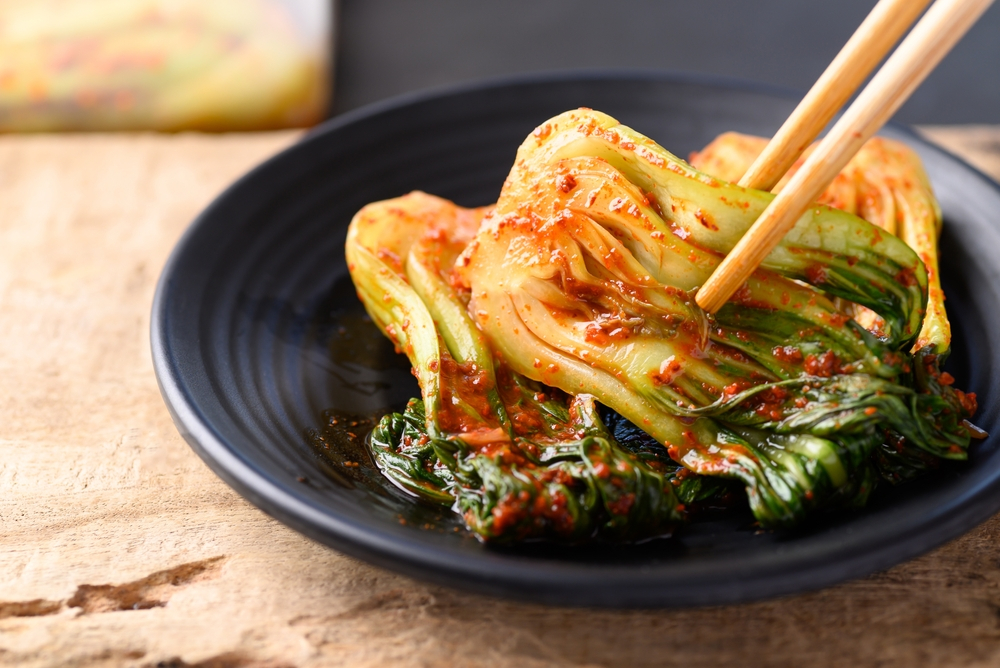
Frequently Asked Questions (FAQs) About Kimchi Bok Choy:
- What is kimchi bok choy?
- Kimchi bok choy, also known as bok choy kimchi, is a traditional Korean fermented side dish made from bok choy (a type of Chinese cabbage) that has been seasoned with a mixture of spices, garlic, ginger, and Korean red pepper flakes (gochugaru). It undergoes a fermentation process that gives it a tangy, spicy, and slightly sour flavor.
- How is kimchi bok choy different from regular kimchi?
- Kimchi bok choy is a variation of kimchi that uses bok choy instead of napa cabbage or other vegetables. It often has a milder and more delicate flavor compared to traditional kimchi.
- Is kimchi bok choy spicy?
- Yes, kimchi bok choy is typically spicy due to the use of Korean red pepper flakes (gochugaru). The level of spiciness can be adjusted to your preference by varying the amount of red pepper flakes used.
- Is kimchi bok choy vegan/vegetarian?
- Kimchi bok choy can be either vegan or vegetarian, depending on the specific ingredients used. Traditional recipes often include fish sauce for flavor, which is not vegetarian, but you can find vegan-friendly alternatives or omit it to make vegan kimchi bok choy.
- How long does kimchi bok choy last?
- Kimchi bok choy has a relatively long shelf life when stored properly. It can last in an airtight container in the refrigerator for several months to a year or more, depending on the level of fermentation and storage conditions.
- Can I eat kimchi bok choy right after making it?
- While you can consume kimchi bok choy shortly after making it, it’s best to let it ferment for at least 1-2 days at room temperature before transferring it to the refrigerator. Fermentation enhances the flavor and develops the characteristic tangy and sour taste of kimchi.
- How can I use kimchi bok choy in recipes?
- Kimchi bok choy can be enjoyed as a side dish on its own, but it’s also a versatile ingredient in various dishes. You can use it in stir-fries, add it to soups, sandwiches, or even as a topping for rice or noodles. The possibilities are endless.
- Is kimchi bok choy healthy?
- Kimchi bok choy is considered a healthy food due to its probiotic content from the fermentation process, which can be beneficial for gut health and your digestive system. It’s also low in calories and a good source of vitamins and minerals providing man health benefits.
- Can I make kimchi bok choy less spicy?
- Yes, you can adjust the level of spiciness in kimchi bok choy by reducing the amount of Korean red pepper flakes (gochugaru) used in the recipe. Start with less and add more gradually until you achieve your desired level of heat.
- Can I freeze kimchi bok choy?
- Freezing kimchi bok choy is not recommended, as it can affect the texture and taste. The fermentation process may continue even in the freezer, causing the kimchi to become overly sour and lose its crunchiness. It’s best to store it in the refrigerator for long-term storage.
- Can you eat raw bok choy
- Yes, you can eat raw bok choy.
- Where can I find kimchi seasoning paste or kimchi powder?
- Asian grocery store, online stores, and your local grocery stores
More Korean Recipes You’ll love:
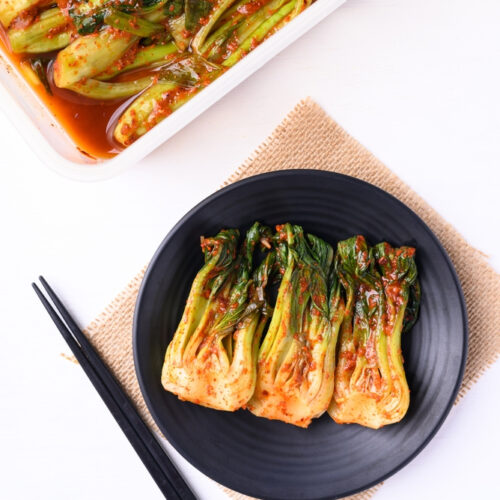
Quick Baby Bok Choy Kimchi Recipe [Easy]
Ingredients
- 4-6 baby bok choy heads
- 1 tbsp kosher salt
- 2 garlic cloves minced
- 1 tsp ginger grated
- 1-2 tsp gochugaru (Korean red pepper flakes) chili flakes
- 1 tsp sugar
- 1 tbsp soy sauce
- 1 tbsp rice wine vinegar
- 1 tsp sesame oil
- 2 green onions chopped
- 1 tbsp toasted sesame seeds optional for garnish
Instructions
- Wash the baby bok choy thoroughly and cut them in half lengthwise
- In a large bowl, dissolve the salt in about 2 cups of water. Submerge the bok choy halves in the saltwater, making sure they are completely covered. soak 20-30 minutes.
- Rinse the bok choy under cold running water to remove excess salt. Drain them well and gently squeeze out any excess water. You want them to be slightly wilted but not soggy.
- In a small bowl, mix together the minced garlic, grated ginger, gochugaru (or chili flakes), sugar, soy sauce, rice vinegar, and sesame oil.
- Place the drained baby bok choy in a large mixing bowl. Add the green onions and the prepared seasoning paste to the bowl. Mix thoroughly
- Gently toss everything together, ensuring that the bok choy is well coated with the seasoning paste.
- Transfer the baby bok choy kimchi to a serving dish, and sprinkle with toasted sesame seeds if desired
- Enjoy immediately, or you can let it sit at room temperature for 30 minutes to allow the flavors to meld a bit.
